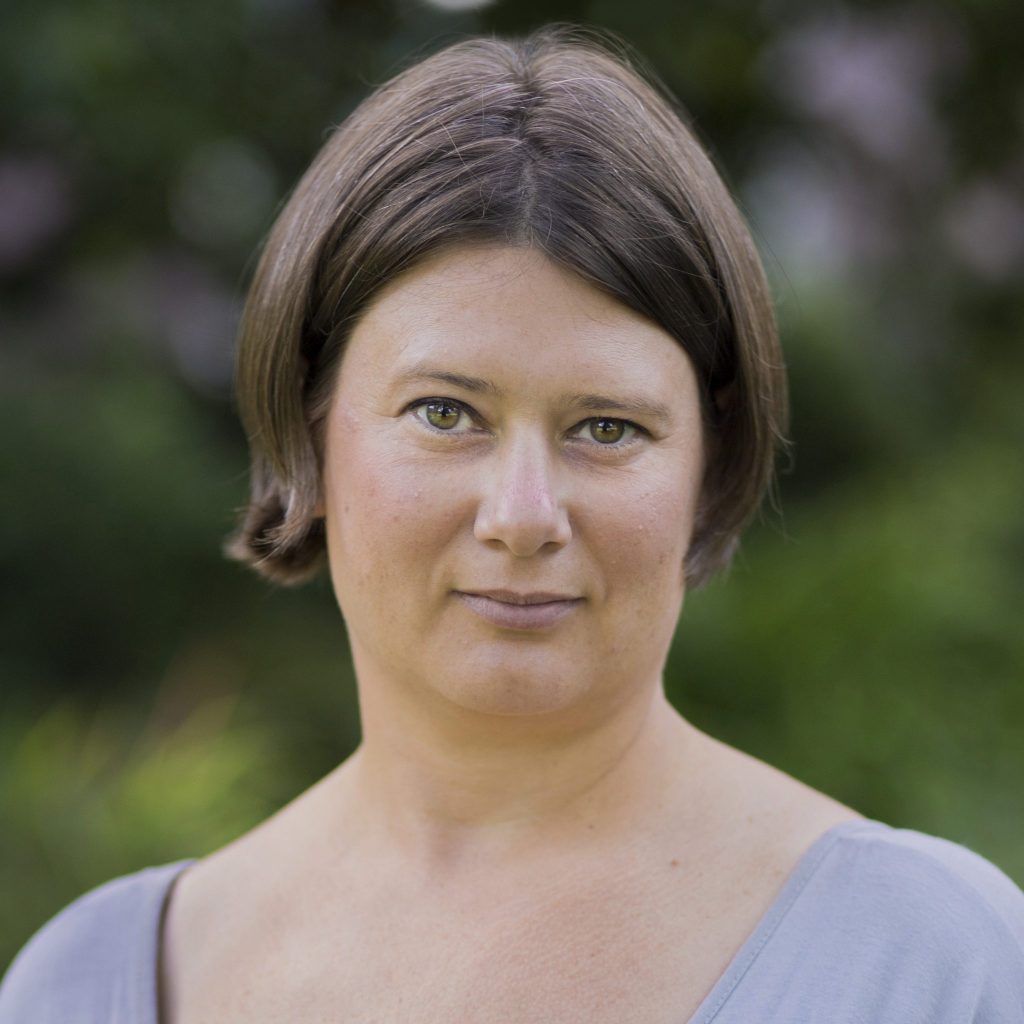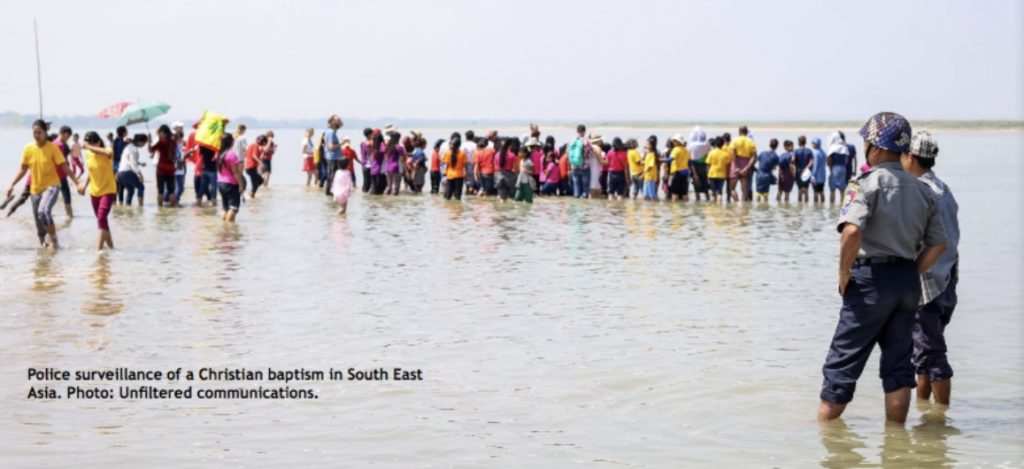In this interview with Kristina Patring, SMC’s advisor for capacity building on FoRB, we explore some of the report’s key messages and policy implications.
This interviewed was conducted via email by Judd Birdsall, editor of Religion & Diplomacy.
Religion & Diplomacy: The report observes that FoRB is often left out of discussions on civic space. Why do you think that is the case?

Kristina Patring. (photo credit: SMC)
Kristina Patring: In our work we find that FoRB is generally less known and more misunderstood than other human rights. In contrast to more “neutral” democratic rights, such as freedom of speech, the right to assembly and the right to form associations, FoRB allows for different, existentially foundational value orientations and faith systems to coexist to a very high degree—even when such systems conflict with or contradict each other. This also makes FoRB as a human right somewhat more difficult to navigate at times. Another contributing factor is the increasing and unfortunate politisation of FoRB at the international level where religion can play into nationalist discourses. We have seen this, for example, in India and Pakistan—two cases that are touched upon by IDEA in their most recent report.
In our new report and in other areas of our work we find that respect for FoRB strengthens democracy by providing space for open and transparent discussions on values, norms, and behavioral change. Without the discussions that FoRB helps to facilitate, societies lose a large degree of their democratic ecosystems. In the report, we see this most clearly in the case of gender relations and women’s rights. There is, for example, an interview in the report where a female representative for Adra Bangladesh point out how,
Men are balancing between the family and the social system, where they feel pushed to ensure that no family member is breaking the community rules, which is a sign of being a “good man.” I think this is a frustrating situation for men who wish to contribute to women’s rights, but find themselves compromising their standpoint due to pressure from traditional structures and attitudes.
R&D: 43% of your respondents reported that state actors tried to hinder or slow down their work. What were some of the most common hindrances?
Patring: The three most common ways in which these organisations experience civic space restrictions from state actors are:
- formal constraints through restrictive regulations and legislation regarding civil society in general, for example in Nepal;
- increasing administrative or bureaucratic burdens, such as more permissions required for CSOs in Tanzania to implement their programmes;
- and formal constraints through restrictive regulations and legislation in relation to religion and religious organisations, as seen in Moldova.
One fifth of the respondents had also experienced serious violations committed by non-state actors (e.g. social movements, religious groups, illegal armed groups). One grave example is Burkina Faso. Since 2015, the country has experienced an increase in religious motivated attacks.
R&D: Did you find that state actors or non-state actors pose a bigger threat to the civic space for faith?
Patring: The pressure from state actors is mainly formal and bureaucratic whereas direct violent pressure more often links to non-state actors. But, in fact, the threat from state actors and non-state actors often overlap so that an organisation will experience double pressure. We regard this combination as the biggest threat because it makes civic space unpredictable for faith-based and other organisations.
Formal pressure from state actors tends to affect more organisations and more people over a long period of time. In our report we find that some faith-based actors have developed different coping strategies to work around these obstacles on a day to day basis. Such strategies range from advocacy for legal rights to networking and dialogue with both other religious actors and state actors. But they also include self-censorship and “going under the radar” in order to be able to operate at all. Thus the problem associated with formal pressure from state actors is more long-term with implications that undermine democracy, civic space, and FoRB.
The pressure from non-state actors was much more directly violent. This immediate threat to life and health puts a lot of stress on the affected individuals and organisations. In our report, violence is however almost always linked to situations of armed conflict and political instability—in itself a threat to democracy and civil society. This indicates that violence from non-state actors is the result of protracted conflict and must be analyzed in context.

A photograph from Claiming Space for Faith showing state surveillance of religious activity.
R&D: The report calls for a gender-sensitive promotion of FoRB because FoRB violations affect men and women differently. What kind of differences did your study uncover?
Patring: In our survey, we asked respondents whether they thought that women and men are affected differently by FoRB violations in their context. Almost half of the respondents thought that women are affected differently than men. They gave examples like:
- unmarried girls and wives not being allowed to choose their own religion or even their own religious interpretation;
- women being discriminated in various ways in society due to religiously motivated norms about gender roles;
- women being forced to carry certain types of dress codes more often than men due to religious reasons;
- and violations of healthcare rights as women in some contexts for religiously motivated reasons were not allowed to decide for themselves if they can see a doctor or how they want to deal with their sexual and reproductive health.
R&D: Many policymakers interested in FoRB or other civil liberties look to major reports from the Pew Research Center and Freedom House for quantitative assessments. Tell us how your study complements those widely-cited studies.
Patring: Our study used Pew Research Center and Freedom House’s reports for triangulation of our data. This made us wish for reports that take both civic data and FoRB data into account. Prior studies look at civic space and FoRB separately and also use different systems for categorisation, etc. We believe this contributes to the continued lack of FoRB and civic space integration among policymakers, who seldom have time to compare quantitative data and differential definitions from multiple sources. Our report does not have the muscle that either Pew or Freedom House have, but we hope we might nudge the research field into a more integrated analysis. Two interesting recent reports on the impact that the pandemic has had on democracy, including FoRB, that I would like to highlight is The Global State of Democracy in Focus, December Brief and V-Dem’s Democracy Report 2020.
In our report we also point out that the mainstreaming of a gender dimension continuously is left out from different FoRB reports. This could be said for well-known reports such as from Pew as well as those coming from USCIRF or the US State Department. These reports usually look at the effects of FoRB violations on religious groups in general; when gender is covered, it is covered either in an ad hoc manner or through specific thematic reports, not as a mainstreamed analytical category. Our suggestion is that it would be very helpful if these big institutions continuously break down the data along both gender and religious dimensions. We believe that this would give us data that are more detailed on the consequences of FoRB violations and thus further help policy makers to ensure both a FoRB and a gender integration in their work on civic space.
R&D: There is an interesting disclaimer at the beginning of the report: “This report focuses on the experiences and discrimination against Christians of different denominations. This is not intended to minimise or make invisible the experiences of other religion and belief minority groups, or to introduce a hierarchy of experience and discrimination. We fully support the rights of all individuals, regardless of their religion or belief.” It is often claimed that Christians are the world’s most persecuted group—and the unstated implication seems to be that they should receive the greatest attention among FoRB advocates. Does your disclaimer challenge that mindset?
Patring: Yes, we want to emphasise the need for everyone to work together for FoRB as a human right for all. Even when our own religious affiliation might mean that we have closer access to the experiences or stories of some specific communities, we need to work for FoRB as a human right for all.
R&D: You suggest that many respondents did not report experience of FoRB violations because, in part, they might “normalise” their situation and simply adapt to a context with lower levels of FoRB protections. I suppose there is something both encouraging and concerning about such situations. How can foreign governments or NGOs engage situations where religious groups and FBOs have creatively adapted to less than ideal environments for FoRB?
Patring: A good start is to increase knowledge about FoRB, as well as acceptance of FoRB, as a human right for all. This applies to both foreign governments and NGOs as well as within societies that have adapted to those less than ideal environments.
The next step could be to introduce different kinds of support to methodology and strategy development adapted to the context. We at SMC have worked with this kind of capacity building for the last seven years. We use both IRL trainings and online trainings through our contribution to the NORFORB owned FoRB learning platform.
Our advice to anyone who wants to promote ForB is to be prepared for slow motion. Technical knowledge about the contents of the right is one thing, and it is important. But maybe even more essential, is that those who are trained are given space to accept and own the values related to FoRB as a human right for all, not just their own group. This creation of ownership takes time and is a more long-term process than that of understanding the technical content of FoRB at a cognitive level. It demands a change in attitudes and mindsets. here there has been, or is ongoing, social or armed conflict and persecution it needs to link up to other forms of truth and reconciliation work and be done with a lot of conflict sensitivity.
R&D: For those governments that are committed to promoting FoRB and civic space at home and abroad, what are two or three key messages they can take from your report that will enhance their ability to promote space for faith?
Patring: First of all, recognise the specific civic space challenges that FBOs often encounter, including non-recognition of religious identity, persecution and harassment of representatives of religious minorities and FBOs.
Second, include FoRB together with other fundamental civic freedoms in the scope of civic space analysis and programming.
Finally, recognise and work with the interlinkages between gender equality and FoRB in analysis and programming.